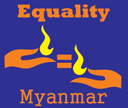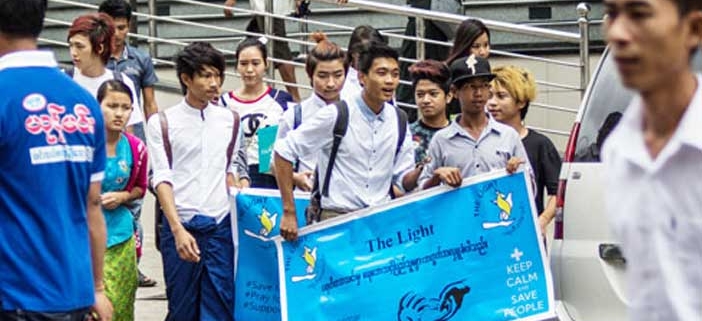Social media drives flood donations
With collection tins and chorus chants, crowds of impromptu aid solicitors are asking for help to “#SaveMyanmar”. By street-stopping passerby across the country, these volunteers seek to raise money for victims of the severe flooding that has ravaged 12 of Myanmar’s 14 states and regions. But in a change from past disasters, powerful fundraising is also happening online.
Thanks to the increased internet accessibility afforded by developing telecommunications networks, social media is generating an influx of donations from both locals and Myanmar living overseas.
On Twitter, the hashtags #supportMyanmar, #saveMyanmar and #prayforMyanmar have been tweeted nearly 57,000 times in the past week. Many of these tweets lead to crowdfunding campaigns on Indiegogo.com, where nine different campaigns have raised US$8984.
The most common tool for fundraisers, however, has been Facebook. Of the 138 donation groups identified on myanmarflood.info, 103 include links to their own Facebook pages.
Ko Soe Htet, co-founder of the “Save Myanmar Flood Victims” Facebook page, said his page was born on August 1. In the five days since its launch, more than 4000 people have clicked “like”.
A masters student at Southeast Missouri State University in the United States, Ko Soe Htet is on summer holiday in Yangon. When the floods hit, he reached out to his friends in America with an idea.
“Me and my brother and one of his friends started this page,” he said. “I told them that we need to do something. There are so many people who need more help. And my brother’s friends started creating the Facebook page. We don’t actually have an organisation or a name – we are just trying to help.”
Part of their mission is to raise awareness of the Myanmar floods in the United States, but their primary focus is raising money to purchase aid and facilitate its delivery.
And although his sister and her friends have collected roughly K1.2 million by asking passerby for donations on busy Yangon streets, Ko Soe Htet’s Facebook group has helped collect more than three times that amount through online donations.
“The internet helps us connect to the people more easily than calling and telling them one by one,” he said. “I just put my phone contact and my street address on the page, and immediately there were so many people messaging me. ‘Oh, you’re doing this? Okay, we want to donate and we don’t know where to go.’ So I was happy about that.”
Ko Soe Htet plans to leave for Pwintbyu, Magwe Region, on August 9 with a group of volunteers. Using a bus sponsored by the International Language and Business Community and three donated container trucks, the volunteers will deliver 10,000 cans of food, 100 bags of rice and nearly 7000 bottles of water. Ko Soe Htet said that his contact in the area, National League for Democracy official U Thein Zaw, estimates 20,000 to 30,000 people in the small town are in need of aid.
Another Facebook group, People to People, reported having raised K844,500 by connecting volunteers to homeowners and businesses that needed help around the house. By offering their time and labour, these volunteers earn money and then donate it to the relief effort.
The group has received another K8.9 million from domestic and international online donations, all in the past seven days. A little less than half of that money has already been donated to needy households in Chin State and Magwe Region.
The outpouring of public support for those affected by the floods – at least 260,000, according to government figures – has drawn comparisons with Cyclone Nargis, which hit the Ayeyarwady delta in May 2008, killing around 140,000.
U Aung Myo Min, executive director of Equality Myanmar and spokesperson for the Myanmar Civil Society Organizations (CSO) Forum, said the push to help flood victims is the largest outpouring of volunteer-driven aid since Nargis.
Communication is one of the major differences this time around.
“The big difference between Nargis and now is the internet and social media. People, particularly young people, use social media a lot to share updates and plan their donations,” he said. “We, as the CSOs, can make alerts, calls and plans through social media.”
Ma Khin Zar Mon, a volunteer with People to People, said she was living in Shan State when Cyclone Nargis struck.
“Most people did not go out of the house to ask for donations,” she said.
“We did not have so many volunteer groups at that time. This year, there are a lot of volunteers who are coming out to help people. Of course, social media is the main part.”
Ma Khin Zar Mon remembers receiving very little information during the aftermath of Nargis. Social media, she said, allows for more people to see pictures and videos of the devastation and motivates them to act.
“The information is more transparent,” she said, “and we can know, immediately, what is happening.”
UPDATE: Social media activity is making headway; Saturday morning, Facebook contacted the creators of Aid for Myanmar Flood Victims to notify them of a dedicated donation page to the crisis. Web users can now visit this page to donate directly to Save the Children, an international nonprofit actively working to deliver aid to affected children in Myanmar.



